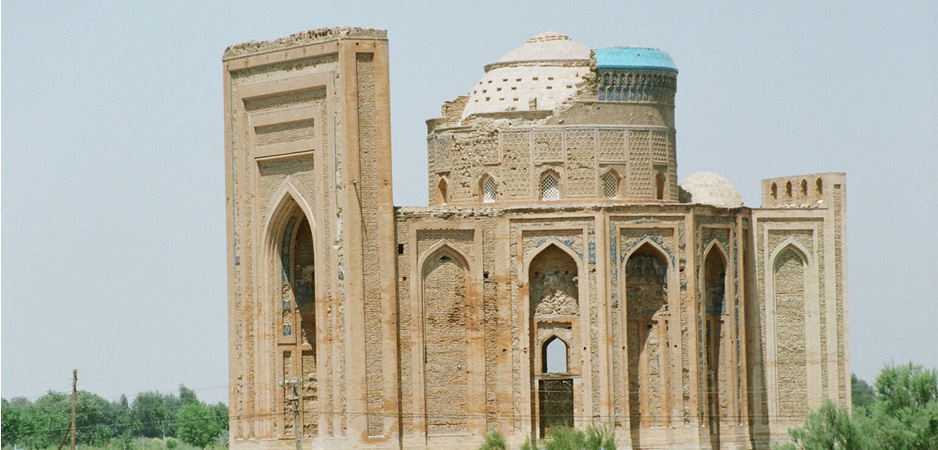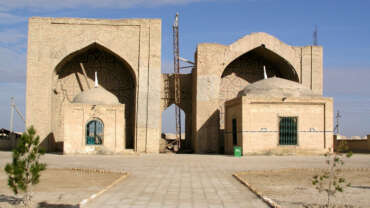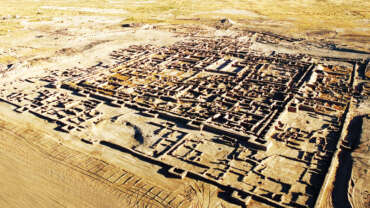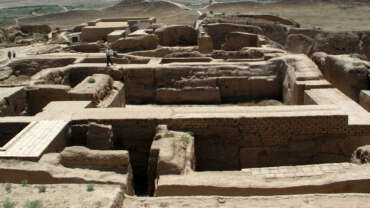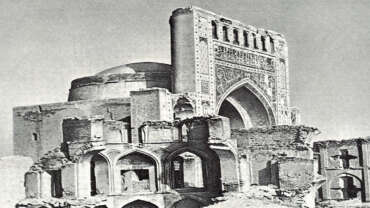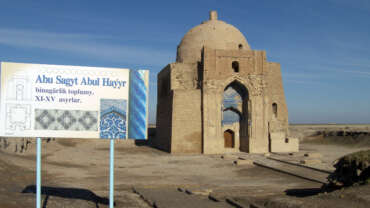Koneurgench – Khorezmshakh civilization
In the Middle Ages in Gurgenge (now Old Urgench in northern Turkmenistan) was formed a unique artistic and intellectual environment, attracted a pleiad of fine scientists and healers, philosophers and poets, artists and builders, pottery, wood carving and stone craftsmen. It was the capital of the Khorezm region, which activities flourished famous school of architecture. The tradition of architecture expressed in the design and craftsmanship of Koneurgench has been influential in the wider region to the south and southwest. The new art and design ideas for a long time «dictated fashions in the architecture of Central Asia and the Caucasus. Even after the disaster of Mongol invasion in the XIII century, the genetic code of the masters of this school has not been interrupted. A few decades later, the city was rebuilt and the talent of architects of this city revealed during the Golden Horde Empire. Prosperity of this architectural school was interrupted at the end of the XIV century, when it won its independence from the Golden Horde and was destroved by the Samarkand’s amir Timur. Famous masters of Old Urgench had to move to Maverannahr where they created marvellous architectural monuments which keep their distinctive style.
This area on the south side of the modem city Koneurgench has remained a vast deserted land with hilly formation of broken bricks, ceramics and clay. In this vast silent space it is able to discern proudly lonely silhouettes architectural structures, some remains of ancient fortified settlements of Gurandj, Urgench and Koneurgench, including a mosque, the gates of a caravanserai, fortresses, mausoleums and a 60 m in height minaret.
On the sample of Koneurgench monuments one can see all variety of methods and decor of Islamic architecture of Central Asia. There are constructions from adobe and burned bricks, plain unicameral dome constructions upgoing to ancient chartak and buildings with complicated compositions, sometimes with a long history of development, repair and reconstruction. These monuments also demonstratethe evolution of methods of treatment of inner surface of domes from celiular sails to stalactite those times called “muqamas” and brought to the highest perfection by local masters. The best monuments of this city are distinguished by high degree of decorativeness. They provide prominent examples of classical arabesques in monochrome terracotta and bright colorfulness of enamel.
The origins of the settlement go back to the V century B.C., and existed here until the XVII century. Archaeological excavations carried out on the hill known as Kyrkmolla revealed the contours of a powerful ancient fortress, built on earlier cultural thicker ceramic V-11 centuries BC. Sure, here is the original core of the city with a strong fortification. This corroborate the supposition of academician S.P.Tolstov that Urgench (the city was called so till the XVI century) was mentioned in the Avesta as Urwah (or Urga). In the Chinese chronicles of the Han dynasty (1 century AD.) Urgench was also mentioned in transcription «Yuegan». The next record, again in Chinese sources, refers to the VII century. In this period revival of Khorezm began. The life revival stoped dead in the IV (left bank of Kunyauaz, Izmykshir, Diyarbekir, Shakhsenem, etc) was revived. In 712, Koncurgcnch was invaded by Arabs and named Gurgenge. Being at the crossing of trade routes from the south to the north-west – to the Volga River, and to the east – in Mongolia and China, the town prospered, becoming a major centre. The beginning of the eleventh century during the reign of Mamun I was filled with military events, the long marches, complex political intrigues. A brief reign of his eldest son Ali ibn Mamun was replaced by another brilliant period of the reign of his son Mamun ibn Mamun. That is the time of prosperity of Gurgenge when it eclipsed Bukhara’s fame and become a centre of scientists, where developed a unique court «Academy» of Mamun.
The great encyclopaedist Abu Rayhan Muhammad ibn Ahmad al-Biruni (973-1050) and a brilliant scientist, physician and philosopher Abu Ah ibn Sina (980-1037), known in the West as Avicenna were the pair of the city. This prosperous period in history of the city did not last long: the enlightened monarch Mamun 11 died in 1017, when Khorezm was conquered by Sultan Mahmud Ghaznavi. Another quarter of a century victorious Seljuks seized power over all the possessions of the Ghaz- navids. Since 1044 Khorezm is only a province of the Great Seljuk Turkmen state.
In 1097 there was an event that marked the beginning of the last dynasty of Khorezmshakhs -the Anushteginids dynasty. Seljukids appointed Qutb al-Din Muhammad I as a ruler of Khorezm. He had been ruled for 30 years and until his death was a loyal subject of Sultan Sanjar, who then did not hesitate to approve his son Atsyz on the throne of Khorezmshahs. However, the Atsyz eventually began to show independence, repeatedly engaging in military confrontation with Sandzhar. Atsyz persistently carried out a policy of «gathering lands», anciently economically gravitate to Khorezm, and gradually subdued the entire north-western part of Central Asia. His grandson Tekesh ibn Il-Arslan in 1194 finally freed Khorezm from Seljuk and expanded their possession to the size of the medieval empire. Under the Tekesh son Ala-ud-Din Muhammad II the state of Khorezmshahs reached the highest power: it stretched from the northern regions of the Caspian to the Persian Gulf and from the Caucasus to the Hindu Kush. AH this brilliant period Gurgenge was the imperial center, where nourished arts, crafts and trade.
In 1221, after half-year siege, Gurgenge was taken and destroyed by the Mongols. However, thanks to its convenient location, the city was rebuilt and described as the finest city of the Turks with fine bazaars and impressive buildings. After joining to the possession of Juchi, and then becoming almost independent in the system Golden Horde Khanate, Khorezm entered into a prosperous phase, which lasted until Timur’s campaigns. This is evidenced by Ibn Battut who arrived in Urgench in 1333 and called it the largest and most prosperous Turkic city. The city was at that time the capital of the vast eastern province of the Golden Horde, and experienced the most brilliant period of its history. Kutlug Timur and his wife Tyurabek Khanum played a special role in its development in the first half of the XIV century. Under the patronage of the famous personalities in Urgcnch was built some marvelous beauty and important significance objects, such as a hospital, a mosque and khanaka. Under their auspices was carried out the restoration of surviving monuments of pre-Mongol period, finished or repaired the minaret by mosque-namazga dated to the XI c., that became one of the highest in the world (about 60 m), and built up a large area within the city walls, which is preserved by 10 km length shaft. It stretches north from the Ak-gala fortress, encircles the entire territory of the current reserve and turns south to the Khorezm-bag fortress. At the south wall flowed the waters of Amudarya (Channel Daryalik).
After 1360 in Urgench Turkmen Sufi dynasty settled independent from the Golden Horde. It suffered heavily from destruction by the Timurid troops between 1372 and 1388, and never gained its previous position again. The best artists, architects, builders and craftsmen had to move to Samarkand. In spite of attempts to restore the city, occurred in 1391, the city has not recovered, because since the XV century began the global processes, that didn’t promote the revival of the city. First, the Amu Darya River changed its course and moved away from the city for about 40 km. Secondly, the political and economic center of the region shifted from Khorezm to Maverannahr (area of Samarkand and Bukhara). Finally, the development of sea routes between Europe, India and China, as well as the discovery of America led to the gradual disappearance of the transcontinental caravan trade and caused a general decline in the economy of Central Asia, which find itself at the periphery of world civilization.
Almost nothing left from the once great Gurgenge, and its ruins have since become known as the Old Urgench (Turkm. “Koncurgenc”). The city experienced modem development took place outside the old town, since 1831 when the Yab Khan channel had been dug here (north of the mausoleum of Najm al-Din al-Kubra). Its coasts formed small village countryside, which became the basis of the present city.
Today Koneurgench is a dynamic city with modern infrastructure. The territory of the old city was announced by the Government of Turkmenistan as the State Historical and Cultural Museum, which architectural and archeological monuments were included in the UNESCO World Heritage List in 2005. Turkmen specialists together with international experts have been constantly working here to study and preserve the unique architectural heritage of the city.



